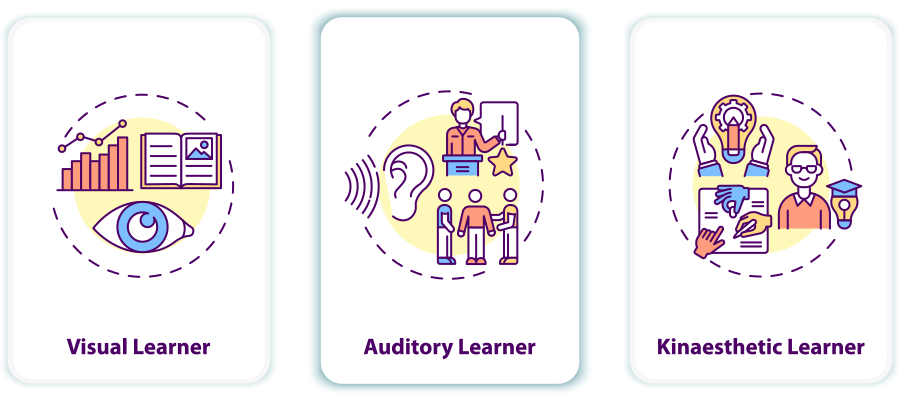ETE is passionate about education and believes that SUBJECT DOESN’T MATTER, HOW YOU TEACH IT DOES. However, we also believe that the way you learn is just as unique and important as our teaching style.
Your learning style affects how you acquire knowledge and absorb information. And many of us go through life unaware of our preferences. By doing so, we may miss out on opportunities to optimize our learning and maximize our potential.
In this article, we’ll review:
- VARK and its benefits
- VARK learning style assessment
- The visual learning style
- The aural (auditory) learning style
- The reading/writing learning style
- The kinesthetic learning style
What is VARK?
VARK (visual, aural, read/write, kinesthetic) is a short and straightforward questionnaire that gives insight into your learning preferences. Many people have found it helpful in understanding others better and learning more effectively.
So, what exactly is a learning style? Simply put, it’s how you naturally prefer to receive and process information. Some people learn best by listening to lectures, reading, or doing hands-on activities. Do you take notes? Draw charts or diagrams? Listen to audio? Everybody learns differently, and we all have preferences that work for us.
Knowing your learning style can impact how you study, practice, and apply your knowledge. If you have never taken the time to understand your own learning style, now is a perfect time. Get to know and understand your learning style: VARK learning style assessment.
Do you prefer to learn by seeing things?
If so, you are likely a visual learner. This learning style involves absorbing information through pictures, diagrams, and other visuals. Visual learners usually have strong imaginations and can easily see the big picture. They are also good at remembering images and stories.
This learning style requires that learners first see what they need to learn.
Visual learners typically:
- Recall what they read rather than what they hear
- Prefer reading stories rather than listening to them
- Like to read
- Find diagrams and charts useful
- Have a tendency for their mind to wander during verbal exchanges
- Are good at spelling
- Need a quiet space to study
- Prefer to work alone rather than in groups
- Ask a lot of questions
- Observe rather than speak or act
Do you prefer to learn by hearing information?
If so, you are likely an auditory learner. This learning style involves listening and having a hands-on approach to tasks. Auditory learners often have an excellent memory for names, dates, and other factual information.
When you learn this way, you hear what you are learning, and your brain remembers information based on how it sounds.
Auditory learners typically:
- Recall what they hear rather than what they read
- Prefer listening to stories rather than reading them
- Prefer to work in groups rather than alone
- Have strong listening skills
- Have good public speaking abilities
- Are good storytellers
- Get distracted by background noises
- Retain information by reading aloud
- Verbally communicate ideas well
- Can communicate effectively
Do you prefer to learn by writing or reading?
If so, you are likely a reading/writing learner. These learners are more confident when they formulate their thoughts instead of just copying someone else’s. They try to understand the underlying meaning of what is being said or written. They can process information well since they have considered it from many different angles and perspectives.
When you learn this way, you comprehend and remember what you read—and you take a lot of notes.
Reading/Writing learners typically:
- Read books that are related to their interests
- Prefer to take notes by hand rather than type them into a computer
- Have several notebooks that they use for different purposes
- Highlight, underline, and take notes in the margins when they read
- Like to write stories or essays about topics that interest them
- Often have an organized filing system for their papers, books, and other materials
- Read over their notes several times and make flashcards out of key concepts
- Answer the easiest questions first before moving on to harder questions
- Do a lot of research and make use of reference materials
- Write or speak using challenging words
Do you prefer to learn by movement?
If so, you are likely a kinesthetic learner. These learners comprehend best by moving or touching while learning, not just sitting quietly. They also like to touch things when exploring the world around them. They may have trouble sitting still for long periods of time, but often find a way to move anyway by wiggling or foot tapping. Additionally, this type of learner has good fine motor skills, excellent hand-eye coordination, and excels in creative subjects.
When you learn this way, you learn most effectively through physical movement.
Kinesthetic learners typically:
- Talk about real things in their life
- Finish tasks
- Enjoy being part of a team
- Use hands-on approaches
- Watch videos
- Use all their senses
- Use plenty of examples when they talk, write, and speak
- Find pictures that illustrate an abstract idea.
- Approach topics creatively
- Have high energy levels
Did the questionnaire help you to learn something new about yourself? Do you have a mixture of two learning styles? With your VARK learning preferences, you can develop additional learning strategies and improve your communication skills. Are you ready to learn even more? VARK provides strategy helpsheets tailored to your learning preferences. Happy learning!

